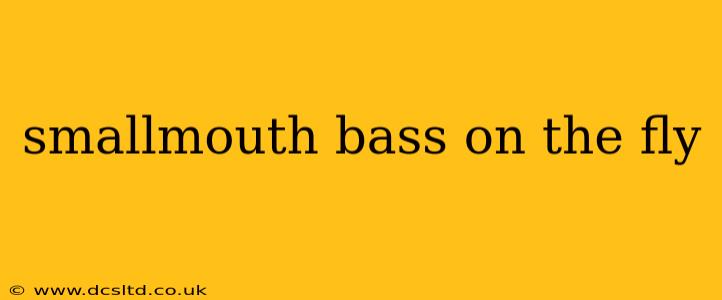The thrill of hooking into a hard-fighting smallmouth bass on a fly rod is an experience every angler should strive for. These feisty fish, known for their acrobatic leaps and powerful runs, offer a unique challenge that keeps fly fishermen coming back for more. This comprehensive guide dives into the intricacies of targeting smallmouth bass on the fly, covering essential techniques, effective tactics, and the best fly patterns to use.
What Flies Work Best for Smallmouth Bass?
The best fly for smallmouth bass depends heavily on the time of year, water conditions, and the specific location you're fishing. However, some patterns consistently prove effective. Smallmouth bass are opportunistic feeders, so mimicking their natural prey is key.
-
Streamers: These are excellent choices, particularly when targeting aggressive smallmouths in faster currents or near structure. Effective streamer patterns include:
- Clouser Minnows: Their profile and weight allow for efficient presentation in various conditions.
- Matukas: These articulated streamers imitate baitfish perfectly and trigger aggressive strikes.
- Sculpins: These imitations of bottom-dwelling fish are particularly effective in rocky areas.
-
Dry Flies: During calmer periods, especially during hatches, dry flies can be incredibly effective. Consider:
- Hoppers: These imitate grasshoppers, a common food source for smallmouths.
- Ants: These small, realistic patterns can be highly effective during periods when ants are falling into the water.
- Caddisflies: These represent a crucial part of the smallmouth's diet in many rivers and streams.
-
Nymphs: Smallmouth bass also feed on nymphs, especially during the cooler months. Effective patterns include:
- Pheasant Tail Nymphs: A classic and versatile nymph pattern.
- Prince Nymphs: A reliable and attractive pattern for smallmouths.
- Hare's Ear Nymphs: Another adaptable pattern that imitates various aquatic insects.
What are the Best Techniques for Fly Fishing Smallmouth Bass?
Mastering several techniques is crucial for success in catching smallmouth bass on the fly. Here are some key approaches:
-
Dead Drifting: Allowing your fly to drift naturally with the current is a highly effective technique, especially for nymphs and smaller streamers. This natural presentation increases your chances of a strike.
-
Stripping: A more aggressive technique, stripping your fly retrieves it in a way that mimics a fleeing baitfish, triggering strikes from more aggressive smallmouths. Experiment with different stripping speeds and rhythms.
-
Nymphing: Using a weighted nymph and indicator, this technique allows you to fish deeper waters and target smallmouths holding near the bottom.
-
Swinging Streamers: In faster currents, swinging streamers across the current can be deadly. The movement of the fly through the water column imitates a struggling baitfish, attracting the attention of hungry bass.
What is the Best Time of Year to Fly Fish for Smallmouth Bass?
Smallmouth bass are active throughout much of the year, but the best time to target them on the fly often depends on your geographic location. However, generally speaking:
-
Spring: As water temperatures rise, smallmouth bass become increasingly active and feed aggressively.
-
Summer: This can be a productive time, but finding cooler, deeper water may be necessary during the hottest periods.
-
Fall: As water cools, smallmouth bass again become more active, preparing for the winter.
-
Winter: While less active, they can still be caught in slower water using appropriate techniques and fly patterns.
What are the Best Locations to Fly Fish for Smallmouth Bass?
Smallmouth bass thrive in a variety of habitats, but some locations consistently produce excellent results:
-
Rivers and Streams: Look for areas with faster currents, rocky structures, and undercut banks.
-
Lakes and Reservoirs: Focus on rocky shorelines, submerged weed beds, and drop-offs.
-
Tailwaters: These areas below dams often have consistently flowing water and abundant insect life, making them great spots for smallmouth bass.
Remember to always respect the environment and practice catch-and-release fishing to ensure the sustainability of these fantastic fish populations.
How do I choose the right gear for fly fishing smallmouth bass?
Selecting the appropriate gear is critical to successfully targeting smallmouth bass on a fly rod. Your choice should consider the type of water you'll be fishing, as well as the size of the fish you expect to encounter.
-
Rod: A medium-fast to fast-action rod in the 7- to 9-weight range is generally ideal. A longer rod (8.5-9 feet) can provide extra reach and casting ability.
-
Reel: Choose a reel with a smooth drag system that can handle the power of a hard-fighting smallmouth. The reel's capacity should accommodate ample backing.
-
Line: A weight-forward floating line is appropriate for most situations. Sinking lines can be beneficial in deeper water or when targeting fish near structure.
-
Leader: A 9- to 12-foot leader is often recommended, with a tippet of 4x to 6x strength, depending on water conditions and fly size.
This guide provides a solid foundation for fly fishing smallmouth bass. Remember, practice, patience, and observation are key to mastering this challenging and rewarding pursuit. Tight lines!
